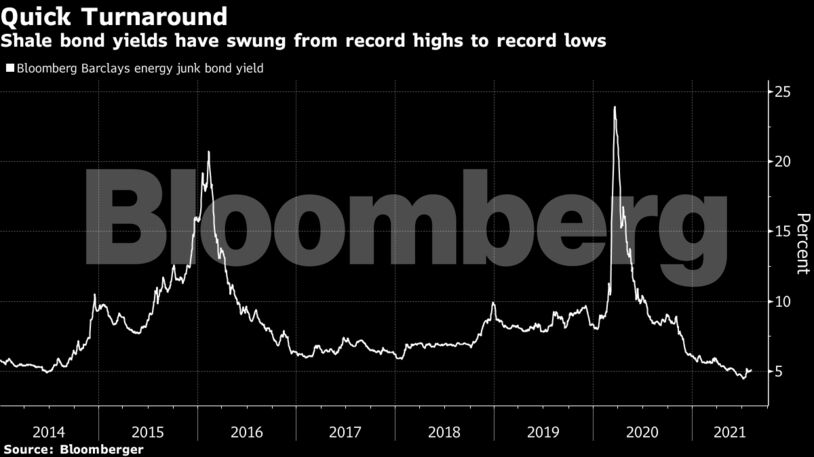America’s oil explorers aren’t repeating the costly mistakes that landed them in hot water with investors, left them almost entirely shut out of debt markets and forced hundreds of them into insolvency over the course of five years. They’re holding the line on production, boosting investor returns and are now attracting the lowest bond yields they’ve ever seen. And instead of using their newly found cheap credit to boom once again, they’re using it to retire costlier debt.
It’s true enough that borrowing costs have plunged across all industries as central banks inject liquidity into their economies. But arguably no sector has benefited from the bonanza of cheap debt more than shale, which about a year ago was on the brink of total collapse — facing a pandemic that sent fuel demand plunging and investors and creditors who, even before Covid-19, had grown weary of waiting for profits.
“We came into this year with too much debt, and we plan to pay debt down,” shale explorer APA Corp.’s Chief Executive Officer John Christmann told analysts and investors last week. “The first priority has been the debt, and clearly we’re on a much faster pace there than we would have envisioned at the start of the year.”
It’s what investors want to hear, and it was repeatedly emphasized by other top producers such as EOG Resources Inc., Pioneer Natural Resources Co. and Continental Resources Inc. in the latest round of earnings calls.
Average yields on non-investment grade energy bonds plunged to an all-time low of less than 5% last month, from almost 24% in March of last year.
The shale patch has gone from 230 bonds trading at distressed levels in April of last year to less than 15 today, according to Bloomberg Intelligence. The industry is also poised to generate more than $30 billion of cash this year, another record, thanks to a surge in crude prices.
As they push maturities back with newer bonds, energy companies face a much smaller wall of debt between now and the middle of next year, at less than $4 billion, Spencer Cutter, an analyst at Bloomberg Intelligence, said.
The last time the shale patch had credit metrics this good, with debt roughly 2.5 times earnings, oil was selling for $100 a barrel in 2014. West Texas Intermediate is trading at about $66 a barrel.
Now energy bonds may be better positioned to weather the next bust. And that’s just where temptation may also lurk.
America’s second-largest drilling-rig contractor, Patterson-UTI Energy Inc., is boosting its own spending this year by 22% from earlier guidance based on conversations it’s having with customers for higher activity ahead. Normally, the Houston company and other hired hands of the oil patch get a break in activity during the final three months of the year after customers blew their drilling budgets and are forced to wait for the new year before growing again.
“You can take fourth-quarter decline and throw it out the window this year,” CEO Andy Hendricks told analysts and investors on July 29. “If you look at where commodity prices are trading — oil above $65 a barrel and natural gas above $3 — we’re not considering a fourth-quarter decline.”
But while the hired hands of the oilfield are talking about higher activity ahead, the explorers themselves are not indicating that just yet. In fact, Tudor Pickering Holt & Co. has warned it will probably reduce its 2022 outlook for onshore U.S. crude-output growth given the signals from executives on second-quarter earnings conference calls.
“Previously, in an improving price environment, the call for growth would have sent the capital to drill better or to acquisitions, as opposed to shareholders,” said Dane Whitehead, CFO of Marathon Oil Corp., which chopped $1.4 billion of its debt faster than anticipated. “We’re kind of in a new paradigm.”
Share This:




 CDN NEWS |
CDN NEWS |  US NEWS
US NEWS 






























COMMENTARY: Markets Call Trump’s Bluff on Russian Oil Sanctions in Increasingly Risky Game – Bousso